
|Articles|April 30, 2021
Optical manifolds, liquid and gas flow
Manifolds from REFLEX are made from food and medical-grade plastic materials with a useful spectral range from UV-vis through near infrared wavelengths.
Manifolds from REFLEX are made from food and medical-grade plastic materials with a useful spectral range from UV-vis through near infrared wavelengths. According to the company, the materials provide for optical clarity, chemical resistance, and low florescence.
REFLEX Analytical Corporation
Ridgewood, NJ
Newsletter
Get essential updates on the latest spectroscopy technologies, regulatory standards, and best practices—subscribe today to Spectroscopy.
Trending on Spectroscopy Online
1
2025 As A Turning Point for Vibrational Spectroscopy: AI, Miniaturization, and Greater Real-World Impact
2
State of the Industry: Spectroscopy at a Crossroads
3
A-TEEM–A Fantastic Spectroscopy that Rivals Raman
4
FT-IR Spectroscopy Links Tourism Intensity to Microplastic Pollution in Island Waters
5




